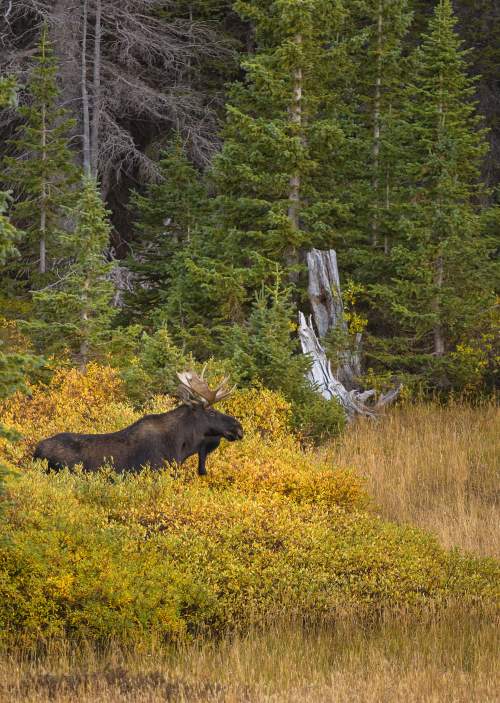Wildlife watching
The Laramie area in southeastern Wyoming provides incredible wildlife viewing opportunities in every direction. The diverse terrain harbors moose, elk, bears, and wolverines, while the sky is filled with the trilling melodies of songbirds and raucous cries of geese.
Moose, Deer, and Elk
West of Laramie, the roads of the Medicine Bow National Forest offer varied wildlife habitat and viewing opportunities. Beaver ponds or small streams bordered by willow, cottonwood, and aspen are the favored stomping grounds of moose, deer, and elk. These animals can be seen any season of the year, but access is easiest before the snow falls and after it melts in spring.
Pronghorn
Until recently, pronghorns were more numerous than humans in Wyoming, and you are likely to catch a glimpse of them on a drive west of Laramie towards the National Forest. White fur on their rumps, sides, and throats makes them easy to identify even at a distance. The fastest land mammal in the Western Hemisphere, pronghorns are able to reach speeds of up to 55 miles per hour over short distances and can outrun a cheetah over long distances. True antelopes never inhabited North America, but 14 species of pronghorn once roamed the vast high plains of the American West. Only the modern pronghorn remains.
Mammals
While out for a hike remember you are only visiting, as various mammals call this place home. If you walk quietly and observe your surroundings carefully, you may spot a red fox stalking its next meal or a cottontail bounding through the brush. Chipmunks, badgers, coyotes, and snowshoe hares are all common here, and elusive wolverines have been spotted. Black bears inhabit higher elevations and demand respect.
Birds
For a glimpse of the sublime, a visitor to the Laramie area need only look up. The coniferous forests of Curt Gowdy State Park host nutcrackers, nuthatches, and chickadees, while reservoirs attract a spring migration of waterfowl. Community gardens at Green Hill Cemetery bring sparrows and warblers on their fall migration, and Jelm Mountain has a summer population of hummingbirds, sapsuckers, and magpies. The sweet song of Wyoming’s state bird, the Meadowlark, rings out on calm days and a patient visitor may spot a Golden Eagle.
More Information
Wyoming Game and Fish Information
Hutton Lake National Wildlife Refuge
Tom Thorne & Beth Williams Wildlife Research Center
Deerwood EcoSanctuary
WILDLIFE VIEWING OPPORTUNITIES
The Hutton Lake National Wildlife Refuge consists of five lakes that host 34 species of water birds. Located about 11 miles southwest of Laramie at 7,150 feet, the refuge offers grassland, open water, and marshes. Managed for conservation and surrounded by high mountains, this is a popular spot with photographers.
Directions: From Laramie head south on Highway 287 for half a mile, then take a right on Fort Sanders Drive. Follow this to the Monolith Concrete Plant, turn right, cross the railroad tracks, and take an immediate left onto County Road 34 (Sand Creek Road). Drive seven miles in a southwesterly direction to signs for the refuge.
In 1948, the Wyoming Game and Fish Department purchased 3,081 acres of land, known at the Johnson Creek Wildlife Habitat Management Area, to serve as winter range for mule deer and to provide the public with recreational hunting and fishing opportunities. Located northeast of Laramie, with easy access, diverse terrain, and adequate space for holding pens, this was also an ideal location for a research facility and the development of the Tom Thorne and Beth Williams Wildlife Research Center which began in 1952. After an outbreak of canine distemper threatened to extinguish the endangered black-footed ferret, the last colony in the world was relocated here from Meeteetse, Wyoming. A successful captive breeding program and release of animals into nearby Shirley Basin provides hope for restoring their numbers.
Directions: From Laramie head north on Highway 287 about 16 miles. Take a right on Highway 34 headed east towards Wheatland. After about 23 miles, look for signs to the Wildlife Research Center on your right.
Located in the Centennial Valley, about 35 miles due west of Laramie the Deerwood Ranch Wild Horse Ecosanctuary is the only one of its kind in the world. The family-owned ranch of almost 5,000 acres has been converted to a wild horse refuge with the removal of cattle guards and various adjustments to loading facilities. The first wild Wyoming horses were delivered in 2012 after a final BLM inspection, and the herd now numbers over 300 geldings with varied color markings, including a few albinos. Call Rich or Jana Wilson at 307-300-9956 or 307-742-3624 to set up a tour.
Directions: From Laramie head west on Snowy Range Road to the junction of Highway 130/230. Take the right fork for Highway 130 marked Airport/Centennial. Drive approximately 20 miles to the junction of Highway 11 and turn left. Drive approximately 10 miles and look for the Deerwood Ranch sign on your right. The ranch house is approximately 1.8 miles west on Deerwood Road.
MAPS
Snowy Range | Highway 230 | Highway 11 | Game & Fish | Hutton Lake | Wildlife Research Center | Deerwood Ecosanctuary
The Laramie area is home to an abundance of wildlife. There are many opportunities to encounter pronghorn (antelope), moose, mule deer, elk, and a plethora of bird life and small mammals.



